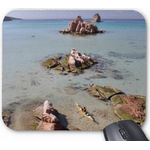In this stage we are going from Uspallata (Argentina) to Santiago de Chile and Valparaiso by bus. In Santiago we visit different neighborhoods, from the crowded touristy to the wealthy ones, and also other curiosities of the capital of Chile. In Valparaiso, we focus mainly on the hills that were declared a World Heritage Site in 2003.
Stage index:
From May 18 to 20, 2011: Santiago de Chile
From May 21 to 22, 2011: Valparaíso
From May 23 to 24, 2011: Santiago de Chile
From May 18 to 20, 2011: Santiago de Chile
Before the sun rises over the Eastern hills of Uspallata, we have loaded the bikes and we are headed toward the house of the kind lady who will keep them while we travel to Chile. During the short ride, our hands have frozen and since we still have a few minutes left for the bus ride to Santiago, we have a coffee and hot chocolate to warm up.
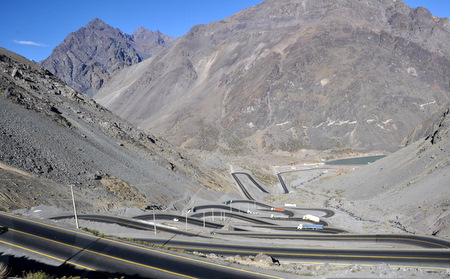 We choose the front seats on the left side of the upper floor of the bus to get a better view, but we almost regret it. From up there and so close to the center of the road the trucks coming from the opposite direction are passing scarily close. The worst is when passing another truck. Then, the cliff to our left appears really high. We know the way up to the border since we just did it by bike. The descent on the Chilean side is more interesting, especially right after the tunnel. As always, the Chilean side of the Andes is steeper and the road has to go down quite a bit in a short distance. In this case, the road has about 30 switchbacks one right after the other. The trucks coming up with great effort drive on the shoulder to make way for faster vehicles. The trucks going down are also very slow, probably using a short gear to help the brakes. Between both lanes of trucks, cars and buses negotiate the central part of the road, ignoring the solid lines on it and the signs prohibiting passing. The 180 degree curves are also used for passing slower vehicles. From our vantage point all these maneuvers look “exciting”.
We choose the front seats on the left side of the upper floor of the bus to get a better view, but we almost regret it. From up there and so close to the center of the road the trucks coming from the opposite direction are passing scarily close. The worst is when passing another truck. Then, the cliff to our left appears really high. We know the way up to the border since we just did it by bike. The descent on the Chilean side is more interesting, especially right after the tunnel. As always, the Chilean side of the Andes is steeper and the road has to go down quite a bit in a short distance. In this case, the road has about 30 switchbacks one right after the other. The trucks coming up with great effort drive on the shoulder to make way for faster vehicles. The trucks going down are also very slow, probably using a short gear to help the brakes. Between both lanes of trucks, cars and buses negotiate the central part of the road, ignoring the solid lines on it and the signs prohibiting passing. The 180 degree curves are also used for passing slower vehicles. From our vantage point all these maneuvers look “exciting”.
Once in Santiago, we go to a tourism office to collect information and maps and head to the hostel we have selected. At the end we decide on an apartment that belongs to the Andes Hostel. It is a perfect choice: modern, with plenty of light, small but immaculate kitchen... The truth is that we deserve it. We are a little tired of gray sheets, washed a hundred times and almost transparent, creaking beds, leaking taps and blackened stoves, faded curtains and windows that don’t fully close. Of course, the apartment is more expensive, but totally worth it.
Our first objective in the capital is to find a medical center to get advice about what type of prophylaxis we should take for the malaria in the Bolivian Amazon jungle and buy the necessary medication. After a couple of wrong places, we come to Andrés’ office at the Darvax center. The three of us talk for a while about our trip and plans in the jungle. Andrés gives us a couple of valuable advice. Perhaps the best is to spray the clothes with a insecticide containing permethrin, like the green Raid bottle (check the active components). After spraying, leave the clothes in a plastic bag for a few hours to coat them well. The clothes with the repellent resists about 4 washings. Regarding the prophylaxis, his recommendation for our particular case, is to not take malaria prevention, but use the emergency pills if we suspect that we have gotten the disease. One reason is the high price of the prophylaxis tablets in Chile and the high number of them we woud have to buy.
Next task is looking for a polarizing filter for the lens of our camera. We broke it a couple of months ago and we haven’t been able to find a replacement because of its uncommon diameter. We just need to know the adequate store and voilà. Finally!
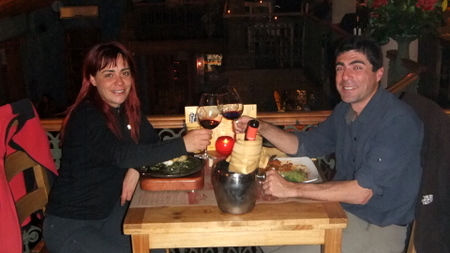 Our third necessity is to replace my trekking boots and swimsuit. We finally find something convincing, though at an alarming cost. Judit also buys better gloves for the Andean highlands we will face farther North. While shopping and doing other chores, we walk through a few of the city´s neighborhoods: Providencia, Las Condes, Brasil, Yungay, Paris-Londres and some more. In the Bellavista neighborhood we do some window shopping. We see all kinds of decorative objects made of lapis lazuli, a semiprecious stone found in the outskirts of Santiago. But the most interesting aspect of this area is the high concentration of restaurants. One evening we have a wonderful seafood dinner at La Boheme. The clams au gratin are spectacular and the locos have nothing to envy. The bottle of wine that accompanies them and the pisco sour that precedes them are also superb. Another night we enjoy the food at the restaurant Como Agua para Chocolate, as well as the Mexican ambience and impeccable service.
Our third necessity is to replace my trekking boots and swimsuit. We finally find something convincing, though at an alarming cost. Judit also buys better gloves for the Andean highlands we will face farther North. While shopping and doing other chores, we walk through a few of the city´s neighborhoods: Providencia, Las Condes, Brasil, Yungay, Paris-Londres and some more. In the Bellavista neighborhood we do some window shopping. We see all kinds of decorative objects made of lapis lazuli, a semiprecious stone found in the outskirts of Santiago. But the most interesting aspect of this area is the high concentration of restaurants. One evening we have a wonderful seafood dinner at La Boheme. The clams au gratin are spectacular and the locos have nothing to envy. The bottle of wine that accompanies them and the pisco sour that precedes them are also superb. Another night we enjoy the food at the restaurant Como Agua para Chocolate, as well as the Mexican ambience and impeccable service.
 Next day we walk through the central market and have lunch in one of its restaurants, but we are not so lucky with our choice. After lunch we go to La Piojera and have a réplica (aftershock), a concoction of cheap wine, fernet (local liqueur) and pineapple ice cream, all mixed in a sticky plastic cup with overflowing pineapple ice cream. To do it the proper way, first we should have had the terremoto (earthquake), the same but in a bigger cup. The replica is enough for us. Machos go for the tsunami after the replica.
Next day we walk through the central market and have lunch in one of its restaurants, but we are not so lucky with our choice. After lunch we go to La Piojera and have a réplica (aftershock), a concoction of cheap wine, fernet (local liqueur) and pineapple ice cream, all mixed in a sticky plastic cup with overflowing pineapple ice cream. To do it the proper way, first we should have had the terremoto (earthquake), the same but in a bigger cup. The replica is enough for us. Machos go for the tsunami after the replica.
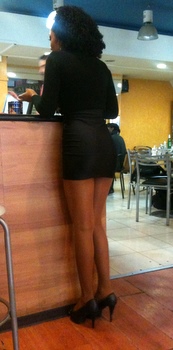 However, what we will not forget from Santiago are the cafes with legs. Those are cafes where waitresses’ dresses are very short. It´s a tradition several generations old and still exists today. At some point in its history, it had a bad reputation because some locals offered more services than just coffee. There even exists the urban legend of the happy minute during which one of the waitresses did a striptease. Today everything is well regulated and coffees are simply served by girls, usually good-looking and scantily dressed. The best without doubt, the mulatto girl at café Pretto.
However, what we will not forget from Santiago are the cafes with legs. Those are cafes where waitresses’ dresses are very short. It´s a tradition several generations old and still exists today. At some point in its history, it had a bad reputation because some locals offered more services than just coffee. There even exists the urban legend of the happy minute during which one of the waitresses did a striptease. Today everything is well regulated and coffees are simply served by girls, usually good-looking and scantily dressed. The best without doubt, the mulatto girl at café Pretto.
Go to top
From May 21 to 22, 2011: Valparaíso
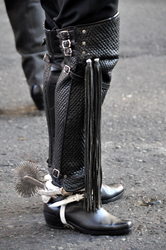 We arrive in Valparaiso in the middle of a demonstration against the government on the day of the presidential speech. While at the downtown army units and some folkloric associations dressed in traditional costumes show their best, in others streets, protesters throw stones and Molotov cocktails to the police who responds with water cannons and tear gas. Our bus has to make a detour to avoid the fuss and to drop us off at the terminal.
We arrive in Valparaiso in the middle of a demonstration against the government on the day of the presidential speech. While at the downtown army units and some folkloric associations dressed in traditional costumes show their best, in others streets, protesters throw stones and Molotov cocktails to the police who responds with water cannons and tear gas. Our bus has to make a detour to avoid the fuss and to drop us off at the terminal.
All the hassle goes away when we begin to climb the slopes of Cerro Alegre. We are staying at the Bed & Breakfast La Nona, where René and Carolina, the owners, have great care for their guests. Besides a copious breakfast and the excelent tourist information they provide, we enjoy pleasant conversations with them about the city, the country and other varied topics.
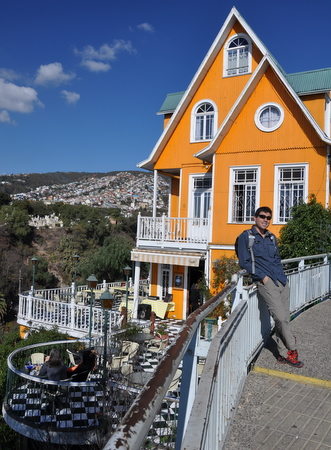 Valpo is a city that generates a series of opposed reactions. On the one hand, the painted murals on the walls of the Alegre, Concepcion, and Bellavista hills are worthy of being watched carefully. However, you also have to take care where you step on or you can get a present stuck in your sole from one of the many stray dogs that roam the city. The passages Yugoslavo, Gervasoni and Atkinson are a good way to get views of the city from above, but these are not too pleasant since the commercial port, its cranes and cargo ships dominate the scenery. However, the craftsmen who exhibit their work, the colonial buildings and palaces are worth it. The elevators, small wooden cabins that go up rattling impossible slopes are unique, besides being the most comfortable way to climb the hills. Unfortunately, of the 14 that exist, only a few are are running nowadays. The old part of the Plan, known as the only flat part of the city, has buildings with ornate facades, columns and friezes but in urgent need of serious restoration and cleaning before they fall apart. In short, the city has incredible potential as a tourist destination and although it’s definitely worth a visit, it could be greatly improved with an investment in restoration and cleaning.
Valpo is a city that generates a series of opposed reactions. On the one hand, the painted murals on the walls of the Alegre, Concepcion, and Bellavista hills are worthy of being watched carefully. However, you also have to take care where you step on or you can get a present stuck in your sole from one of the many stray dogs that roam the city. The passages Yugoslavo, Gervasoni and Atkinson are a good way to get views of the city from above, but these are not too pleasant since the commercial port, its cranes and cargo ships dominate the scenery. However, the craftsmen who exhibit their work, the colonial buildings and palaces are worth it. The elevators, small wooden cabins that go up rattling impossible slopes are unique, besides being the most comfortable way to climb the hills. Unfortunately, of the 14 that exist, only a few are are running nowadays. The old part of the Plan, known as the only flat part of the city, has buildings with ornate facades, columns and friezes but in urgent need of serious restoration and cleaning before they fall apart. In short, the city has incredible potential as a tourist destination and although it’s definitely worth a visit, it could be greatly improved with an investment in restoration and cleaning.
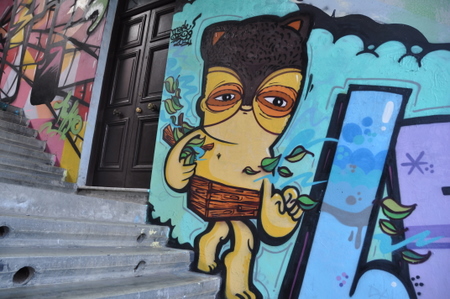 The walk that connects Valparaiso and Viña del Mar is modern and provides an area to stroll away from downtown traffic. A few use it to jog or ride. Sea lions, oblivious to all this, sleep in the ugly concrete blocks along the promenade.
The walk that connects Valparaiso and Viña del Mar is modern and provides an area to stroll away from downtown traffic. A few use it to jog or ride. Sea lions, oblivious to all this, sleep in the ugly concrete blocks along the promenade.
The cafes of the city are another of the refuges from the bustle of the streets. You can try different variations of coffee and all kinds of real fruit smoothies. In particular, the Café Subterráneo has a myriad of choices and the Café Paseo has and old but sophisticated atmosphere that is worth visiting.

Go to top
From May 23 to 24, 2011: Santiago de Chile
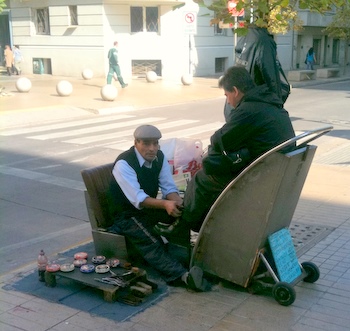 Back in Santiago we continue with our long walks around the city. We visit the outside of the Museo de la Memoria, referring to the sad period of dictatorship the country went through. In the courtyard, the walls have engraved all the articles of the Human Rights Declaration so that no one would forget again.
Back in Santiago we continue with our long walks around the city. We visit the outside of the Museo de la Memoria, referring to the sad period of dictatorship the country went through. In the courtyard, the walls have engraved all the articles of the Human Rights Declaration so that no one would forget again.
One of the visits we liked the most is the Pre-Columbian Art Museum of Chile. It focuses on pre-Columbian cultures of Central and South America. From the Olmecs and Aztecs cultures in Northern Mexico, to the Mayans and Incas and lesser-known cultures farther South like Diaguita, Chinchorro or Moche. The quality and condition of the ceramics, statues and fabrics is amazing. On top of it, the texts that accompany them are quite informative, especially in Spanish.
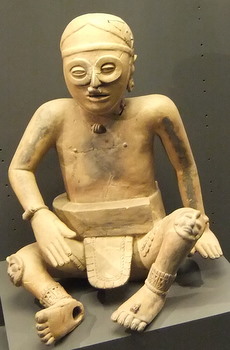
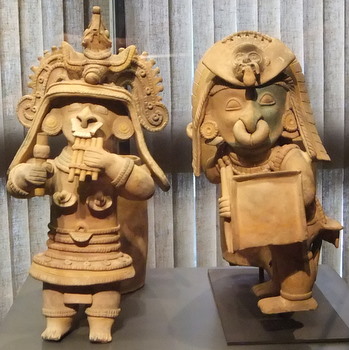
Santiago has a lot more to see, but in our short visit we already got a good impression of the capital. We wouldn’t mind leaving some time here. However, our bikes are waiting for us in Argentina, ready to ride along the tracks of the Cordillera, so we get ready to leave our lair of white sheets and take the bus back to Uspallata. As we get close to the Cristo Redentor tunnel, we realize that the surrounding peaks are already covered in snow. It reminds us that winter is chasing us again. We must keep moving North with no delay.
Go to top
© 2014 Explore Pangea. All Rights Reserved. Website
Terms
of Use.










